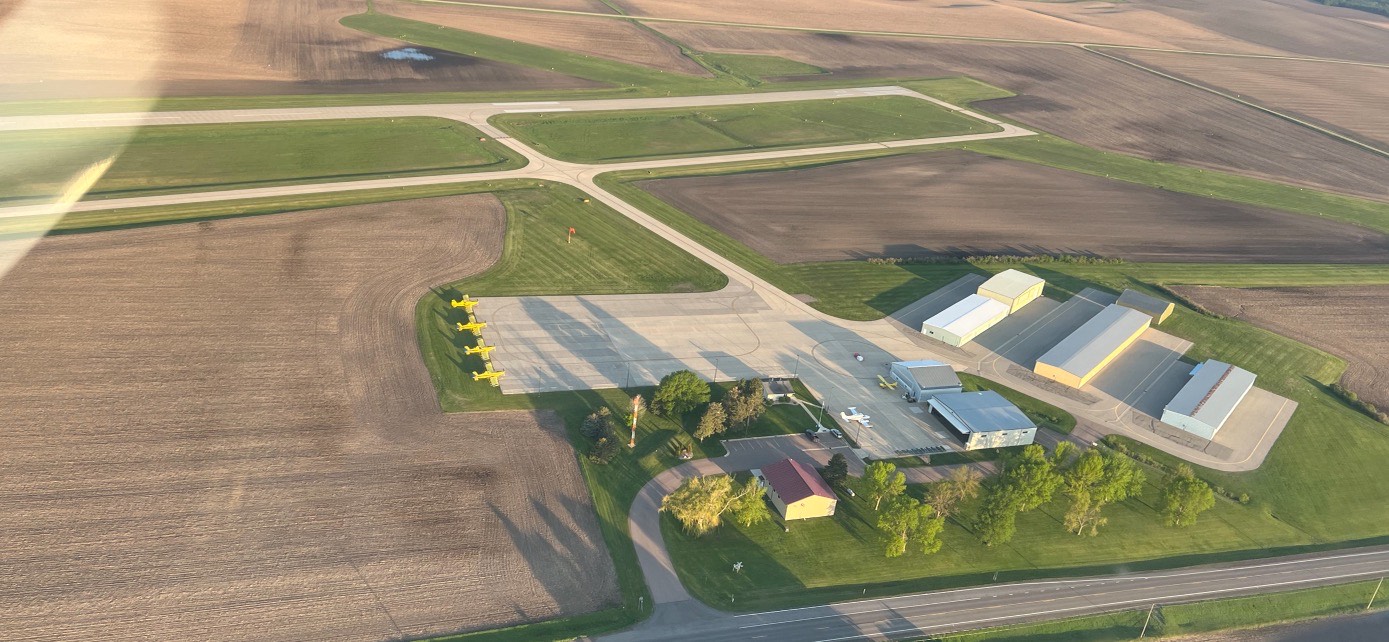
It’s easy to spot Owatonna Degner Regional Airport when passing by on Interstate 35: the display at its entrance has become a distinctive landmark. Three T-38 jet aircraft, arranged in a starburst formation and painted in US Air Force Thunderbird colors, have been welcoming visitors to the airport since 2006. According to waymarking.com, the display—years in the making—had previously flanked the site of the nearby Heritage Halls Museum until it closed.
Owatonna Degner Regional Airport, located about an hour south of the Twin Cities, has been enjoying the benefits of a recent development boom in the Owatonna area over the past year; a number of companies have relocated to or expanded their current facilities in the region. The largest of those is Costco, which is constructing a 354,000-square-foot facility to serve as its distribution center in the Upper Midwest.
Airport manager Dave Beaver says the airport was a factor in attracting business development to the community—particularly Costco. A recent article in Twin Cities Business magazine reported that the local airport was one of the things that Costco looked at when it selected the Owatonna location. One key asset is the airport’s 5,500-foot runway with an Instrument Landing System (ILS), which regularly accommodates all sizes and classes of corporate turbine aircraft.
“It’s rewarding to see the regional impact the airport has on supporting local business needs,” Beaver says. “The airport is certainly an important economic development tool for the community, supporting existing business needs as well as community growth. Costco is a great example of that.”
The airport serves a wide range of general aviation traffic with a busy flight school and significant business aviation use along with local, transient, military, and ag operations. Facilities include a 24-hour-accessible corporate area with a pilot lounge, conference room, flight planning room, and modern passenger lobby. The airport offers fueling services, overnight hangar service, and a courtesy car for use in the local area.
In addition to businesses in the greater Owatonna area, the airport property is home to thriving businesses. Langer Aviation, which has been at the airport since 2004, provides general aircraft maintenance and aviation restoration. In February, Trident Aviation Training arrived, offering a modern flight simulator and training in initial instruction, advanced ratings, “rusty pilot,” and instrument refresher and currency.
February also saw the arrival of Accelerated Aviation Instruction (AAI), which relocated to Owatonna from Albert Lea. The business offers accelerated flight instruction—full-time one-on-one instruction in a condensed timeframe. At Owatonna, AAI gained more classroom space, larger offices, and a heated hangar. The move also allowed AAI to upgrade its fleet of training aircraft. The company’s flight simulator, a Redbird LD, has been authorized by the FAA as an Advanced Aircraft Training Device. The hours logged in this simulator can fulfill up to 20 hours needed for the Instrument Rating, and up to 50 of the 250 hours required for the Commercial Pilot Certificate, according to AAI’s website.
The flight schools have been an exciting addition, Beaver says. “It brings people to the community from all over to stay in hotels and use other local services.” Beaver notes that the airport has a strong Civil Air Patrol squadron presence as well.
Growing over the years
The airport opened on a temporary site on Owatonna’s West Bridge Street, in 1946. Operations were moved to the present site north of the city in July of 1947. In 1987, the airport was named for Glenn Degner, who had served in the aviation branch of the Navy and was the airport’s first operations director.
Beaver has been with the airport since 1996 and seen numerous changes during that time—the most significant of which occurred in the 1990s with a multi-year $15 million improvement project. The length of the primary concrete runway was increased to 5,500 feet; other new additions included an ILS, parallel taxiway, hangars, a fuel system, parking lot, maintenance building, and modern terminal building. Crosswind runway 5/23 was completed in 2009, providing landing options with 3,000 feet of paved and lighted runway.
In the mid-1990s, the airport had approximately 25 based aircraft; it’s around 60 currently. General aviation has changed, too, in terms of the cycles of demand for flight instruction and how it fluctuates over time, Beaver says.
Pandemic pain
Like other airports, Owatonna has felt the effects of COVID-19. Numerous events were canceled this year—a fly-in breakfast, civil air patrol dance, youth aviation camp, and airport movie night. With fewer people traveling for business, corporate aviation has taken a big hit, particularly in the early months of the pandemic. This activity appears to be trending back to more normal levels as companies look at transportation alternatives. Another bright spot: Piston aircraft operations have stayed fairly strong, Beaver says. “One upside impact of the pandemic may be that people have more time to spend on flying their own plane, or learning to fly,” he says.
“Now we kind of look at it as an opportunity…We feel like businesses will be looking at different ways [to travel]. They’ll still have a need—maybe they won’t want to fly the airlines but will charter, or explore aircraft ownership options,” he says.
Looking ahead
Beaver says that with the airside facilities in good shape, the airport is looking for ways to continue meeting the community’s needs. Long-term plans may include opening up other quadrants of the airport for business development.
“We want to make sure we’re meeting aviation demand, keeping up first-class facilities and services, accommodating based aircraft, and supporting local business aviation needs” Beaver says. The airport’s T-hangars are currently occupied and it’s looking to expand capacity to meet demand by building another hangar next year.
Beaver says he always loved airplanes, and in his current role he’s immersed in aviation. “I love working in the industry. And there are great people in [it]. Folks fly in from all over the country,” he says. “I like how an airport works, the benefits it provides its community.”

